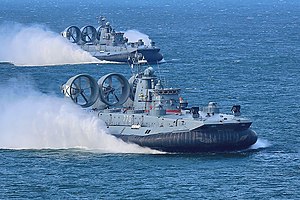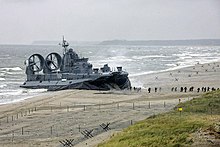 Mordoviya and Evgeniy Kocheshkov Mordoviya and Evgeniy Kocheshkov
| |
| Class overview | |
|---|---|
| Builders | PO More in Feodosiya of Crimea, Khabarovsk shipyard, Almaz, Pribaltisk Yantar |
| Operators | |
| In commission | 1986–present |
| Planned | 17 |
| Building | 2 |
| Completed | 15 |
| Cancelled | 2 |
| Active | 10 |
| Scrapped | 5 |
| General characteristics | |
| Type | Air-cushioned landing craft |
| Displacement |
|
| Length | 57 m (187 ft) |
| Beam | 25.6 m (84 ft) |
| Draught | 1.6 m (5.2 ft) |
| Propulsion |
|
| Speed |
|
| Range | 300 nmi (560 km) at 55 knots |
| Complement | 31 (4 officers, 27 enlisted) |
| Sensors and processing systems | Ekran-1 navigational radar, Lazur radar (Pozitiv radar on MDK-51), R-782 Buran communications system |
| Electronic warfare & decoys | Electronic Countermeasures System: Decoys, MS-227 chaff launcher, MP-411 ESM radar system; intercept |
| Armament |
|
The Zubr class, Soviet designation Project 1232.2, (NATO reporting name "Pomornik") is a class of Soviet-designed air-cushioned landing craft (LCAC). The name "Zubr" is Russian for the European bison. This class of military hovercraft is, as of 2023 the world's largest hovercraft, with a standard full load displacement of 555 tons. The hovercraft was designed to sealift amphibious assault units (such as marines and tanks) from equipped/non-equipped vessels to non-equipped shores, as well as to transport and plant naval mines.
Ten Zubr-class hovercraft remain in service. There are two vessels in the Russian Navy and four with the Hellenic Navy. In 2009 China placed an order for four vessels from Ukraine as part of a deal worth US$315 million. Two updated versions of the vessels were built by Crimea's Feodosia Shipbuilding Company, followed by two advanced models of the surface warship. In 2023, an additional two more were built and modernized, with both hulls being numbered as 3260 and 3261.
The purchase in 2000 of HS Cephalonia (L 180) for the Hellenic Navy marked the first time a Soviet-designed naval craft had been built for a NATO member.
In June 2017 Russia announced the restarting of production of Zubr-class craft. Representatives from the Russian shipbuilding industry soon after responded by stating production could not possibly resume in 2018 and would only be possible by 2019–2021, refuting the government position. Representatives cited the lack of availability of and inability to mass-produce components, notably gas-turbine engines and reduction gears as the main obstacles.
NPO Saturn (ODK GT) and Turboros developed marine gas turbine engines M70FRU (D090), FR RU, M70FRU2 (DP/DM71) along M90FR, M75RU, E70RD8 and Elektrosila, AO Zvezda, Metallist, Samara and others developed redactors and gears.
History
| This section needs expansion. You can help by adding to it. (August 2022) |
The Zubr class landing craft were developed in the 1980s and the first operational group entered service in 1986. From 1985 to 1993 and 2001 and 2004, a total of 15 units of the class were laid down in Saint Petersburg and Feodosia. After the end of the Soviet Union, two boats at the shipyard were scrapped before they were completed, and three boats from the Black Sea Fleet were handed over to Ukraine, which itself built another boat. As of 2001, three new boats were built for Greece.
Configuration

High strength and buoyancy is provided by a rectangular pontoon, the main load-carrying part of the ship's hull. The superstructure built on the pontoon is divided into three compartments with two longitudinal bulkheads: combat material compartment in the midsection fitted with tank ramps, and outboard sections housing main and auxiliary propulsion units, troop compartments, living quarters, and NBC protection systems. To improve working conditions in the battle stations, troop compartments and living quarters are fitted with air-conditioning and heating-systems, sound/heat-insulating coatings, and structures made of vibration damping materials. The ship provides normal conditions for the crew to make meals and rest.
Personnel are protected against the effects of weapons of mass destruction by airtight sealing of combat stations, crew and troop compartments, augmented with individual gas masks and protection suits. The ship is also protected from magnetic influence mines with an active system to compensate for the magnetic fields generated by the ship and transported materials. The central command post and MS-227 device compartments are strengthened with alloy armor.
Capacity

The Zubr-class landing craft has a cargo area of 400 square metres (4,300 sq ft) and a fuel capacity of 56 tons. It can carry three main battle tanks (up to 150 tonnes), or ten armoured vehicles with 230 troops (up to 131 tonnes), or eight armoured personnel carriers of total mass up to 115 tonnes, or eight amphibious tanks or up to 500 troops (with 360 troops in the cargo compartment).
At full displacement the ship is capable of negotiating up to 5-degree gradients on non-equipped shores and 1.6 m (5 ft 3 in)-high vertical walls. The Zubr class remains seaworthy in conditions up to Sea State 4. The vessel has a cruising speed of 30–40 knots (56–74 km/h; 35–46 mph).
Later models built by Ukroboronprom for the People's Republic of China are reported to travel at a top speed of 63 kt. The range of 300 nautical miles is obtained at 55 kt cruise. A licensed-built version of this model is in service with the Chinese People's Liberation Army Navy designated as the Type 958.
Operators
| This section needs additional citations for verification. Please help improve this article by adding citations to reliable sources in this section. Unsourced material may be challenged and removed. (July 2018) (Learn how and when to remove this message) |
![]() Russian Navy (ex-Soviet Navy) (2)
Russian Navy (ex-Soviet Navy) (2)
- 770 Evgeniy Kocheshkov (former MDK-50)
- 782 Mordoviya (former MDK-94)
![]() Hellenic Navy (2 + 2)
Hellenic Navy (2 + 2)
- HS Cephalonia (L 180, former MDK-118)
- HS Ithaca (L 181, former U421)
- HS Corfu (L 182)
- HS Zakynthos (L 183)
- 6 (2 delivered from Ukraine, 4 built in China)
Former operators
![]() Ukrainian Navy (4)
Ukrainian Navy (4)
- Donetsk (U420, former MDK-100) — decommissioned on 11 June 1999, scrapped
- Kramatorsk (U422, former MDK-57) — decommissioned on 11 June 1999, scrapped
- Horlivka (U423, former MDK-93) — decommissioned on 29 November 2000, scrapped
- Artemivsk (U424, former MDK-123) — sold to Greece on 24 January 2000
See also
References
- ^ "More Zubr-class amphibious assault hovercraft for the Chinese Navy". Naval News. 2023.
- ^ Wertheim (2007), p. 128.
- ^ Jane's Information Group (2002).
- ^ "Zubr Class (Pomornik) Air Cushioned Landing Craft, Russia". Naval-Technology.com. 2011. Retrieved 2 August 2011.
- зубр Russian Wiktionary
- Wilkinson, Freddie. "Guinness world record hovercraft". Guinness world record.
- "Hellenic Command Amphibious Forces: Ships". Hellenic Navy. 2008. Archived from the original on 4 August 2008. Retrieved 18 April 2009.
- ^ Rahmat, Ridzwan (6 March 2014). "Ukraine crisis prompts hurried delivery of second Zubr LCAC to China". IHS Jane's. Archived from the original on 2 August 2014. Retrieved 5 January 2015.
- "China To RePay $14 Million Debt To Crimea For Zubr-class Landing Craft". Defenseworld.net. 29 January 2015. Retrieved 5 December 2017.
- "Hellenic Command Amphibious Forces: Introduction". Hellenic Navy. 2008. Archived from the original on 9 March 2009. Retrieved 18 April 2009.
- Kitov, Vladimir (4 November 2000). "Almaz launches NATO-bound craft". The Russia Journal. Archived from the original on 12 March 2016. Retrieved 18 April 2009.
- Titova, Irina (29 December 2000). "City Shipyard Hovercraft Is 1st Delivery to NATO State". The St. Petersburg Times. Archived from the original on 5 June 2011. Retrieved 18 April 2009.
- "Russian ship joining Greek navy". BBC News. AVN Military News Agency. 20 December 2000. Retrieved 18 April 2009.
- Jones, Bruce (16 June 2017). "Russia to resume construction of Zubr hovercraft". IHS Jane's 360. Archived from the original on 16 June 2017. Retrieved 16 June 2017.
- "Production of Zubr-Class Air-Cushion Ships Resumes Only in 2019-2021, Shipbuilders Say". Mil Today. 18 June 2017. Archived from the original on 19 June 2017. Retrieved 19 June 2017.
- "Россия полностью заменила украинские комплектующие для военной техники" [Russia has completely replaced Ukrainian components for military equipment]. Armstrade.org (in Russian). 14 September 2018.
- "ОДК закрыла потребность флота в двигателях, ранее поставлявшихся Украиной" [UEC closed the fleet's need for engines previously supplied by Ukraine]. Armstrade.org (in Russian). 9 September 2019.
- "Chinese built Type 958 LCAC". Sohu (in Simplified Chinese). 12 September 2020.
- "Zubr LCAC". www.globalsecurity.org. Retrieved 22 April 2024.
Bibliography
- Saunders, Stephen (2003). Jane's Fighting Ships 2003-2004. Jane's Information Group. ISBN 978-0-7106-2546-5.
- Jane's Information Group (2002). Jane's International Defence Review. Jane's Information Group. Retrieved 18 April 2009.
- Wertheim, Eric (2007). The Naval Institute Guide to Combat Fleets of the World: Their Ships, Aircraft, and Systems (15th (illustrated) ed.). Naval Institute Press. ISBN 978-1-59114-955-2. Retrieved 18 April 2009.
External links
- NikolaiGrigorjev (11 July 2007). "ZUBR". YouTube (in Russian). Archived from the original on 19 December 2021.
- "Zubr Class (Pomornik)". Naval Technology.com.
- "Πλοία Ταχείας Μεταφοράς" [Fast Transport Ships]. Hellenic Navy (in Greek).
- "Зубр". Wiktionary.org.
- "All Zubr class LCAC - Complete Ship List". Russian Ships. Archived from the original on 8 November 2010.
- "Десантный корабль "Зубр" проект 12322" [Landing ship "Zubr" project 12322]. Almaz Shipbuilding Company (in Russian). Archived from the original on 16 March 2017.
| Soviet and Russian ship classes after 1945 | |
|---|---|
| Aircraft carriers | |
| Battlecruisers | |
| Cruisers | |
| Destroyers | |
| Frigates | |
| Corvettes | |
| P / M / T boats |
|
| Minesweepers | |
| Amphibious ships |
|
| Spy ships | |
| Air-cushioned landing craft | |
| Icebreaking patrol vessels | |
| Other vessels | |
| |
| Ukrainian ship classes | |
|---|---|
| Aircraft carriers | |
| Cruiser | |
| Frigate | |
| Corvette | |
| A / M / T boats | |
| Amphibious ships Fast assault craft | |
| Air-cushioned landing craft | |
| Other | |
| |
| Frigates |  | |
|---|---|---|
| Gunboats | ||
| Submarines | ||
| Fast attack craft | ||
| Mine warfare ships | ||
| General support ships | ||
| Auxiliary ships | ||
| Training ships | ||
| Landing vessels | ||